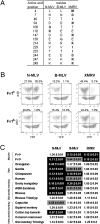Susceptibility of xenotropic murine leukemia virus-related virus (XMRV) to retroviral restriction factors
- PMID: 20194752
- PMCID: PMC2841911
- DOI: 10.1073/pnas.0913650107
Susceptibility of xenotropic murine leukemia virus-related virus (XMRV) to retroviral restriction factors
Abstract
Xenotropic murine leukemia virus-related virus (XMRV) is a recently discovered gammaretrovirus that has been linked to prostate cancer and chronic fatigue syndrome. This virus is therefore an important potential human pathogen and, as such, it is essential to understand its host cell tropism. Intriguingly, infectious virus has been recovered from patient-derived peripheral blood mononuclear cells. These cells express several antiviral restriction factors that are capable of inhibiting the replication of a wide range of retroviruses, including other gamma retroviruses. This raises the possibility that, similar to HIV, XMRV may have acquired resistance to restriction. We therefore investigated the susceptibility of XMRV to a panel of different restriction factors. We found that both human APOBEC3 and tetherin proteins are able to block XMRV replication. Expression of human TRIM5alpha, however, had no effect on viral infectivity. There was no evidence that XMRV expressed countermeasures to overcome restriction. In addition, the virus was inhibited by factors from nonhuman species, including mouse Apobec3, tetherin, and Fv1 proteins. These results have important implications for predicting the natural target cells for XMRV replication, for relating infection to viral pathogenicity and pathology, and for the design of model systems with which to study XMRV-related diseases.
Conflict of interest statement
The authors declare no conflict of interest.
Figures




Similar articles
-
Human APOBEC3 proteins can inhibit xenotropic murine leukemia virus-related virus infectivity.Virology. 2011 Feb 5;410(1):234-9. doi: 10.1016/j.virol.2010.11.011. Epub 2010 Dec 4. Virology. 2011. PMID: 21131013 Free PMC article.
-
Moloney murine leukemia virus glyco-gag facilitates xenotropic murine leukemia virus-related virus replication through human APOBEC3-independent mechanisms.Retrovirology. 2012 Jul 24;9:58. doi: 10.1186/1742-4690-9-58. Retrovirology. 2012. PMID: 22828015 Free PMC article.
-
Severe restriction of xenotropic murine leukemia virus-related virus replication and spread in cultured human peripheral blood mononuclear cells.J Virol. 2011 May;85(10):4888-97. doi: 10.1128/JVI.00046-11. Epub 2011 Feb 16. J Virol. 2011. PMID: 21325415 Free PMC article.
-
Intracellular defenses against HIV, viral evasion and novel therapeutic approaches.J Formos Med Assoc. 2011 Jun;110(6):350-62. doi: 10.1016/S0929-6646(11)60053-3. J Formos Med Assoc. 2011. PMID: 21741003 Review.
-
HIV Restriction Factors and Mechanisms of Evasion.Cold Spring Harb Perspect Med. 2012 May;2(5):a006940. doi: 10.1101/cshperspect.a006940. Cold Spring Harb Perspect Med. 2012. PMID: 22553496 Free PMC article. Review.
Cited by
-
Evaluation of cellular determinants required for in vitro xenotropic murine leukemia virus-related virus entry into human prostate cancer and noncancerous cells.J Virol. 2010 Jul;84(13):6288-96. doi: 10.1128/JVI.00274-10. Epub 2010 Apr 21. J Virol. 2010. PMID: 20410264 Free PMC article.
-
Tetherin restricts productive HIV-1 cell-to-cell transmission.PLoS Pathog. 2010 Jun 17;6(6):e1000955. doi: 10.1371/journal.ppat.1000955. PLoS Pathog. 2010. PMID: 20585562 Free PMC article.
-
Of Mice and Men: On the Origin of XMRV.Front Microbiol. 2011 Jan 17;1:147. doi: 10.3389/fmicb.2010.00147. eCollection 2010. Front Microbiol. 2011. PMID: 21687768 Free PMC article.
-
Restriction of porcine endogenous retrovirus by porcine APOBEC3 cytidine deaminases.J Virol. 2011 Apr;85(8):3842-57. doi: 10.1128/JVI.01880-10. Epub 2011 Feb 9. J Virol. 2011. PMID: 21307203 Free PMC article.
-
The gammaretroviral p12 protein has multiple domains that function during the early stages of replication.Retrovirology. 2012 Oct 4;9:83. doi: 10.1186/1742-4690-9-83. Retrovirology. 2012. PMID: 23035841 Free PMC article.
References
Publication types
MeSH terms
Substances
Grants and funding
LinkOut - more resources
Full Text Sources
Other Literature Sources
Research Materials

